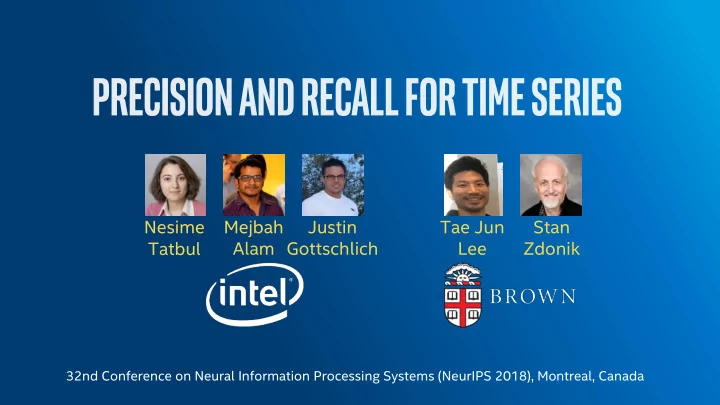

Nesime Mejbah Justin Tae Jun Stan Alam Gottschlich Lee Zdonik Tatbul 32nd Conference on Neural Information Processing Systems (NeurIPS 2018), Montreal, Canada
Motivation: Time Series Anomaly Detection Anomaly: Patterns that do not conform to expected behavior. Anomalies can have critical impact: loss of life, property damage, monetary loss, ... Applications of anomaly detection (AD) are numerous and diverse. Autonomous Driving Cancer Detection Six levels of autonomy: L0: No automation L1: Driver assistance Anomalies L2: Partial automation often occur L3: Conditional automation L3+ autonomy over a L4: High automation requires robust period of time. L5: Full automation AD systems. Source: Society of Automotive Engineers (SAE), Source: National Highway and Traffic Safety Administration (NHTSA) http://www.vaccinogeninc.com/oncovax/science-due-diligence/overview-part-1 2
Motivation: Range-based Anomalies Time series anomalies are range based , i.e., they occur over a period of time. Atrial Premature Contraction anomaly in human ECG There are domain-specific application preferences . – Cancer detection, Real-time systems: – Early response; Avoid false negatives! – Robotic defense systems: – Delayed response; Avoid false positives! – Emergency braking in self-driving cars: Source: Chandola et al., “Anomaly Detection: A Survey”, – Neither too early nor too late; Avoid false negatives! ACM Computing Surveys, 41(3), 2009. 3
Problem: How to Measure Accuracy? Point-based Anomalies Range-based Anomalies T rue P ositives F alse F alse N egatives P ositives 𝑄𝑠𝑓𝑑𝑗𝑡𝑗𝑝𝑜 = ? 𝑆𝑓𝑑𝑏𝑚𝑚 = ? 𝑄𝑠𝑓𝑑𝑗𝑡𝑗𝑝𝑜 = 𝑈𝑄 ÷ (𝑈𝑄 + 𝐺𝑄) Must express partial detection 𝑆𝑓𝑑𝑏𝑚𝑚 = 𝑈𝑄 ÷ 𝑈𝑄 + 𝐺𝑂 Must support flexible time bias 4
State of the Art Classical Precision and Recall 𝑄𝑠𝑓𝑑𝑗𝑡𝑗𝑝𝑜 × 𝑆𝑓𝑑𝑏𝑚𝑚 𝛾 = (1 + 𝛾 2 ) × 𝐺 (𝛾 2 × 𝑄𝑠𝑓𝑑𝑗𝑡𝑗𝑝𝑜) + 𝑆𝑓𝑑𝑏𝑚𝑚 – Point-based anomalies β : relative importance of Recall to Precision – Precision penalizes FP, Recall penalizes FN β = 1 : evenly weighted (harmonic mean) β = 2 : weights Recall higher (i.e., no FN!) – F β -Score to combine and weight them β = 0.5 : weights Precision higher (i.e., no FP!) Numenta Anomaly Benchmark (NAB) [2] – Point-based anomalies – Focuses specifically on early detection use cases – Difficult to use in practice (irregularities, ambiguities, magic numbers) [3] Activity recognition metrics – No support for flexible time bias [2] Lavin and Ahmad, “Evaluating Real -Time Anomaly Detection Algorithms – The Numenta Anomaly Benchmark”, IEEE ICMLA, 2015. 5 [3] Singh and Olinsky , “ Demistifying Numenta Anomaly Benchmark”, IEEE IJCNN, 2017.
Precision and Recall for Time Series Customizable parameters We extend classical Precision and Recall to measure ranges. Range-based Recall Our model is: – expressive – flexible – extensible Range-based Precision 6
Customization Examples Overlap Size ω() Positional Bias δ() Cancer Detection: Robotic Defense: Emergency Braking: Set δ () = Front-end , β = 2 Set δ() = Back-end , β = 0.5 Set δ() = Middle , β = 1.5 Our model subsumes the classical point-based model , when: all ranges are represented as unit-size ranges, and α=0 , γ()=1 , ω() is as above, and δ() = Flat 7
Selected Experimental Results Comparison to Classical model Comparison to Numenta model Multiple Anomaly Detectors (LSTM-AD) (LSTM-AD) (NYC-Taxi) Our model Our model can Our model is more effective in subsumes the classical model mimic the Numenta model evaluating multiple detectors is sensitive to positional bias catch additional intricacies capturing subtleties in data Please see our paper for details of this experimental study and additional results. 8
Key Takeaways This work extends the classical Precision and Recall model to time series data. We provide tunable parameters to capture domain-specific application preferences. Experiments with diverse datasets and anomaly detectors prove the benefits of our approach. Future work includes: – designing new training strategies for range-based anomaly detection – exploring use in other time series classification tasks and applications 9
More Information Watch our short video: https://www.youtube.com/watch?v=K5f-dUBiQP4 Read our paper: https://arxiv.org/abs/1803.03639/ Download our tool: https://github.com/IntelLabs/TSAD-Evaluator/ Visit our poster session at NeurIPS’18: Today at 5:00 - 7:00 PM in Room 210 & 230 AB #116 Thanks to Intel and NSF for funding this research. 10
Recommend
More recommend